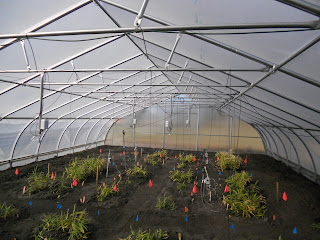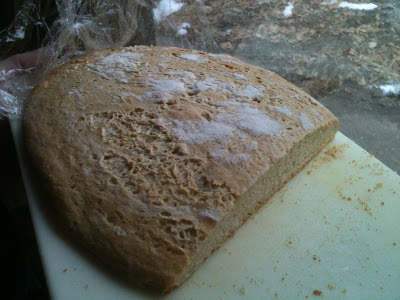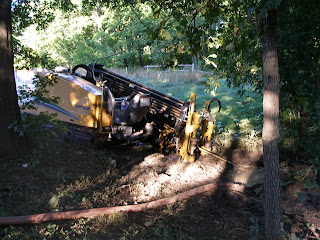Waseca Research Ginger
On October 10, 2012 we visited the University of Minnesota,
Waseca Research Station. We were visiting the ginger growing area at the
station to see what type of growing techniques they were using in the
considerations for commercial ginger. We walked down to 2 high tunnel-growing
facilities. The researchers were growing ginger under different conditions =
to
calculate the plant=92s
phyto-nutrient content of gingerol. The gingerol is used in cancer research by the Hormel Cancer Institute.
The growing beds wer=
e prepared with soil of 5 to 6% organic
material and 30 - 40% clay. The soil seemed pretty silty to me, but it was =
very
dry on the surface. The beds are also fertilized with 100 pounds nitrogen p=
er
acre. Urea is used in the beginning because of the clay soil. The seed tube=
rs
are purchased from a supplier In Hawaii and look much like the ginger root =
you
might see in the store. Tis=
sue
cultures are used in Indonesia for starting plants. The Hawaiian plants are=
planted
at 6 in spacings 3 to 4 inches deep. Deeper plantings reduce the chances of=
a
successful harvest. The seed root then sends out rhizomes and begins growin=
g
new tubers atop the old one. 60 pounds of seed root can yield 600 pounds of
ginger root tubers at harvest. These single-season tubers are round and very
thin-skinned. They do not look like the usual retail ginger roots from the
store. But they taste and contain the same nutrients.
Shade cloth was used over some of the beds. Sections are
being tested for growth under shade of 30%, 50%, and 70%. In the deepest shade
the plants create more rhizomes but less gingerol per pound. In the 30% sha=
de
area and in diffuse sunlight under the high tunnel, plants had less foliage=
and
larger roots. In each case the phenotypic response of the plants produced o=
nly
the amount of leaf area necessary for photosynthesis. The root, however, being
less or more concentrated in phyto-nutrients was relative to the leaf size and
overall produced similar amounts of gingerol per plant regardless of sunlight
treatment. The more transmissive shade cloth produced less rhizomes but mor=
e
gingerol. More dense shade cloth produced more rhizomes and less gingerol.
Researchers were also testing different soil temperatures,
placing tables at 16 inches beneath the soil surface. Tubers were placed 4
inches above the table, but the depth of the soil reduced plant growth or
plants did not emerge at all. Data loggers are used on all the planting bed=
s to
keep track of moisture and soil temperature. The planting beds are in a double
plastic sealed hoop house using an air pump to inflate The space between the
layers of plastic and increase insulation. Even with this there was some frost
damage early in the fall and it showed on the leaves as light brown striations
running the length of the leaf ridges. Ginger seems to be highly susceptible to
cold temperatures. High tunnels for season extension are mandatory to grow ginger
commercially. Care must be taken in managing the high tile to make sure that
the temperature remains consistently high and failures in the structure do =
not
destroy the crop. In the 2nd high tunnel we visited, row covers were
being used to keep the plants warm and reduce frost damage. Row covers and
stratifying the air mass within high tunnels can buffer the temperature changes
during the night. Larger high tunnels supply more thermal mass and heated air
which takes longer to cool during the cold nights. Other storage sources of
thermal mass might be recommended for serious commercial production of ginger.
Auxiliary heat and dynamic insulation systems would ensure the crop against
extreme weather.
--
Posted By Blogger to PERMACULTURE AND PERENNIAL FOOD F= OREST DESIGN at 10/24/2012 09:25:00 PM --f46d042de41b6edd3b04ccd8e930--





Comments